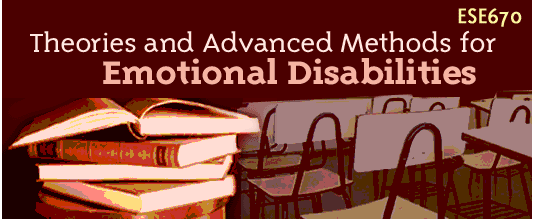
 |
|||||
| |
|
|
|
|
|
Objectives
6. Demonstrate knowledge of prevalent diagnoses (e.g., depression, anxiety, conduct disorders) and their characteristics as they pertain to educational programming and educational interventions for students identified as E/BD
8. Demonstrate the ability to make programming and management decisions impacting students identified as E/BD
In this module, you will show that you can take the tools you have as a disciplinarian and manager and blend them with the strengthened ability to diagnose that comes from your coursework. Once you can put a name and set of symptoms or behaviors with a child, you have a large body of research that can guide decisions and choices.
In addition, you also can pull from a strong body of past experiences in other classrooms and educational setting through your research. Of course, once you have this strengthened position to work from, you also have the ability to support the home efforts and work as a team.
This scenario presupposes a couple of vital pieces. The first is that you have gained and will be using all this information in a sense of service to the child and family. The second is that you have come to appreciate the youngster and the diagnosis is much more than a label – not something you will use to excuse the child or the system, but as a stepping stone to being more compassionate, brave, strong-hearted and focused in helping the child more to better health and make educational gains.
What? How dare a person intimate anything else? Well, 25 years in the system as teacher and social worker explains how there could be a question. It is easy for a teacher and family to feel overwhelmed by a barrage of challenging behavior.
It is easy to “catch” the anger, the panic, the anxiety of the child from all the spill of emotion and start to react rather than manage the situation.
As human beings, we can ‘behave’ for a while, but even the most stalwart soul can be wearied, lose heart, get frustrated, feel hopeless, have a bad day. When that happens, chances are the teacher will lose sight of the immediate goal and say or do something that shames them or makes them wish they had reacted differently. (You know about that if you are being honest --- those ruminating times you go over and over something you said and wish could be unsaid – that sense of hope that others saw it in a more positive light and that no damage was done). Those loops, going over and over something usually signal times when we were not at our best.
We try hard, work hard, give a lot --- but we are human and learn by doing, after all.
There are no great answers except time, patience and perseverance to unlocking some of the student actions and outbursts, and while that is happening it can be disheartening, wearing, sometimes dangerous. It is easy to lose sight of the possibility for success . . . And there is pressure from the rest of the school for the child to behave when s/he steps out of the classroom. So sometimes, you, the teacher, mentor, counselor and supporter – need just to let go for a while, to relax, to have an easy day – not to have someone calling names and challenging everything said from “ time to do math” to “please put your chair back on four legs.”
It is important to consider this as you prepare to scrutinize youngsters, make program decisions and put labels and discussions of who a child is in permanent records. The readings and activities may help you determine the most ethical and pro-student ways to approach these delicate and crucial steps.